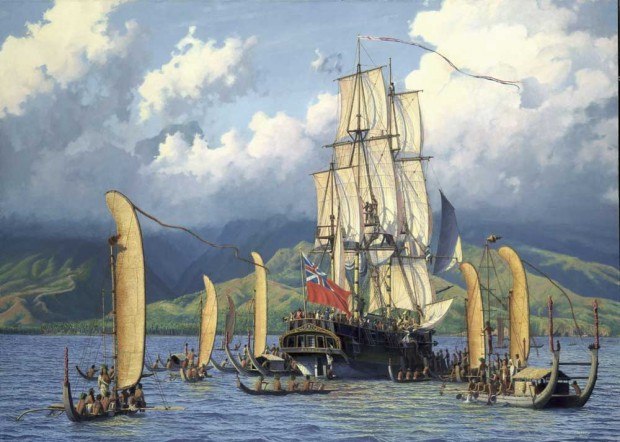The poised brush strokes of maritime artist Raymond Massey have brought the age of sail back to Kapa‘a. His historical masterpiece, “The H.M.S. Bounty,” is currently on view at Ship Store Gallery in Kapa‘a. Raymond Massey, a noted maritime historian in the United States, has his works hanging in places such as the Smithsonian’s National Maritime Museum, The White House, The United States Naval Academy and The British Admiralty in Greenwich, England.
Born in Tyne England in 1938, Massey learned to paint after reading the journals and log books of Captain James Cook. Fascinated by the age of sail and the explorers who traversed the vast Pacific Ocean, Massey picked up a paint brush and hit historical archives in Britain and the United States. Each painting has at least five-to-seven years of intense research poured into it, including ship blue prints, crew manifest, logs, charts, voyage routes and mission assignments.
Massey unveiled this painting at the San Diego Maritime Museum in 1995. This painting captures the imagination, taking its viewers on a voyage through time.
When the H.M.S. Bounty set sail from England in 1787, her main mission was to attain breadfruit from Tahiti in the South Pacific and bring it to the West Indies as a cheap means of feeding sugar plantation workers. Originally christened the Bethia, she was a small merchant ship that was refitted to accommodate the plants. After being renamed The Bounty, she set sail for the South Pacific with only a small essential crew and one naval officer, William Bligh. Bligh was also the young sailing master on board with Capt. James Cook when he stumbled upon the Hawaiian Islands in 1778.
Ten months out of England and having sailed 27,086 nautical miles, the Bounty and her weary crew arrived in Tahiti. Having been there with Capt. Cook on his third voyage, Bligh new of a bay to drop anchor. Matavai Bay is where Cook observed the Transit of Venus 19 years prior.
Needing five to six months to take the breadfruit from seedling to sapling, Bligh allowed his men that did not have ships duty or watches to roam freely through the jungles of Tahiti. Many of these sailors being far from home and loved ones found the beautiful Tahitian women quite appealing and many sired children in the months onshore. Most of these men had never left England before and never experienced the splendor of the tropics and her people. Coming from cold and damp England, Tahiti was a true paradise for these young sailors.
By the time the Bounty departed Tahiti, she had been there for six months. On the morning of April 28, 1789, Fletcher Christian, the acting first mate and his crew mutinied. They cast Bligh and 18 of his loyal crew adrift in a 23 foot launch. Amazingly, they reached safety after sailing more than 3,600 nautical miles at sea.
The Bounty, under Christian’s command, returned to Tahiti. Then he and eight mutineers, six Tahitian men, twelve women and an infant child, sailed to the island of Tubai. The local natives there provided a hostile environment. Christian’s attempts to find a permanent settlement failed on Tubai and they left.
When seal hunters landed at Pitcairn in 1808, there was only one member of the Bounty left. Today their descendants still thrive on Pitcairn.
Ship Store Gallery is proud to show Massey’s Masterpiece and to tell the story of Thomas Treichler, the man who commissioned Massey to paint the Bounty in 1994. Treichler, a Swiss born attorney and former Princeville resident, commissioned Massey to paint his favorite sea going vessel in 1994 after having a lifelong affinity for the Bounty.
It took Massey over a year after extensive research to create the work. Massey’s meticulous research efforts are revealed in the journal supporting the historic scene he paints. It traces the painting from idea, through the research, to the final brush stroke, showing the artist’s strict adherence to authenticity. Massey will not commit art to canvas until he knows every available bit of information about his subject. Massey’s works are not copied out of a book or borrowed from others but are created as truly authentic historic recreations that come to life because of painstaking research, exacting attention to detail and immense pride of accomplishment.
The painting is on display at Ship Store Gallery from 9 a.m. to 7 p.m. daily.





